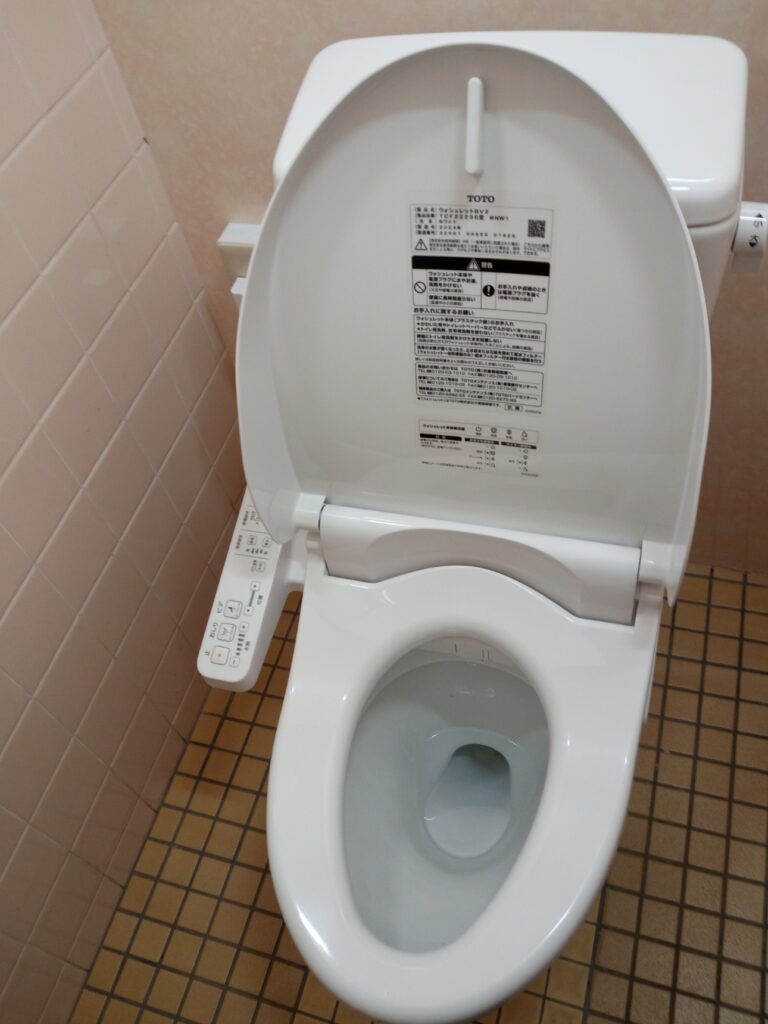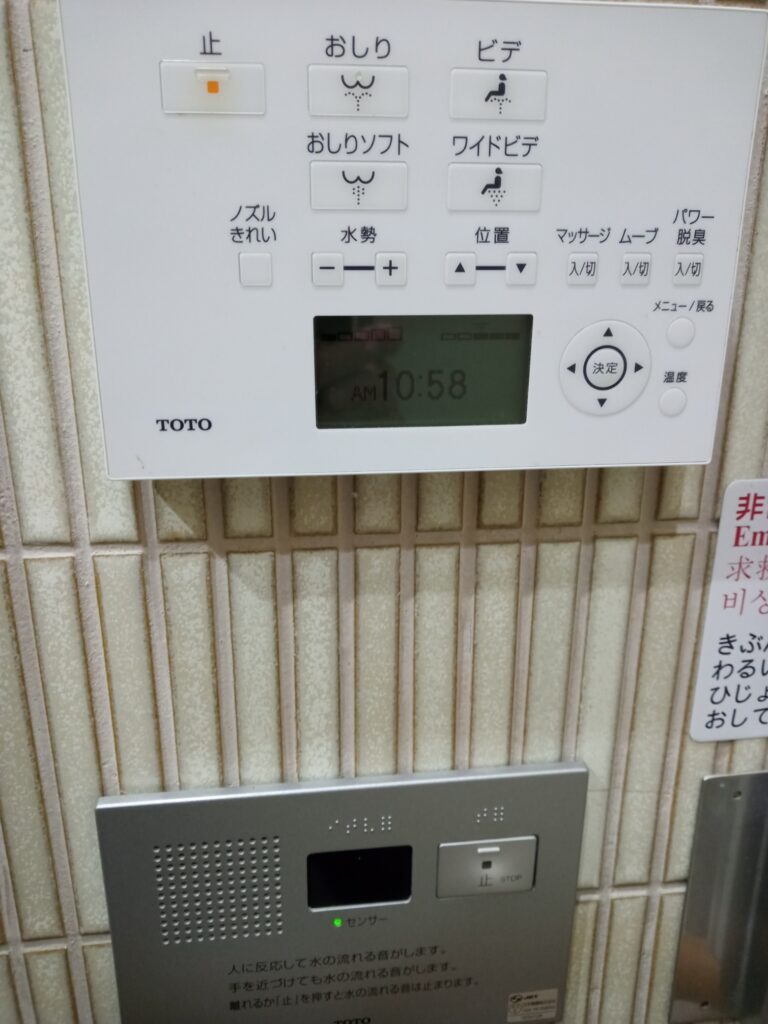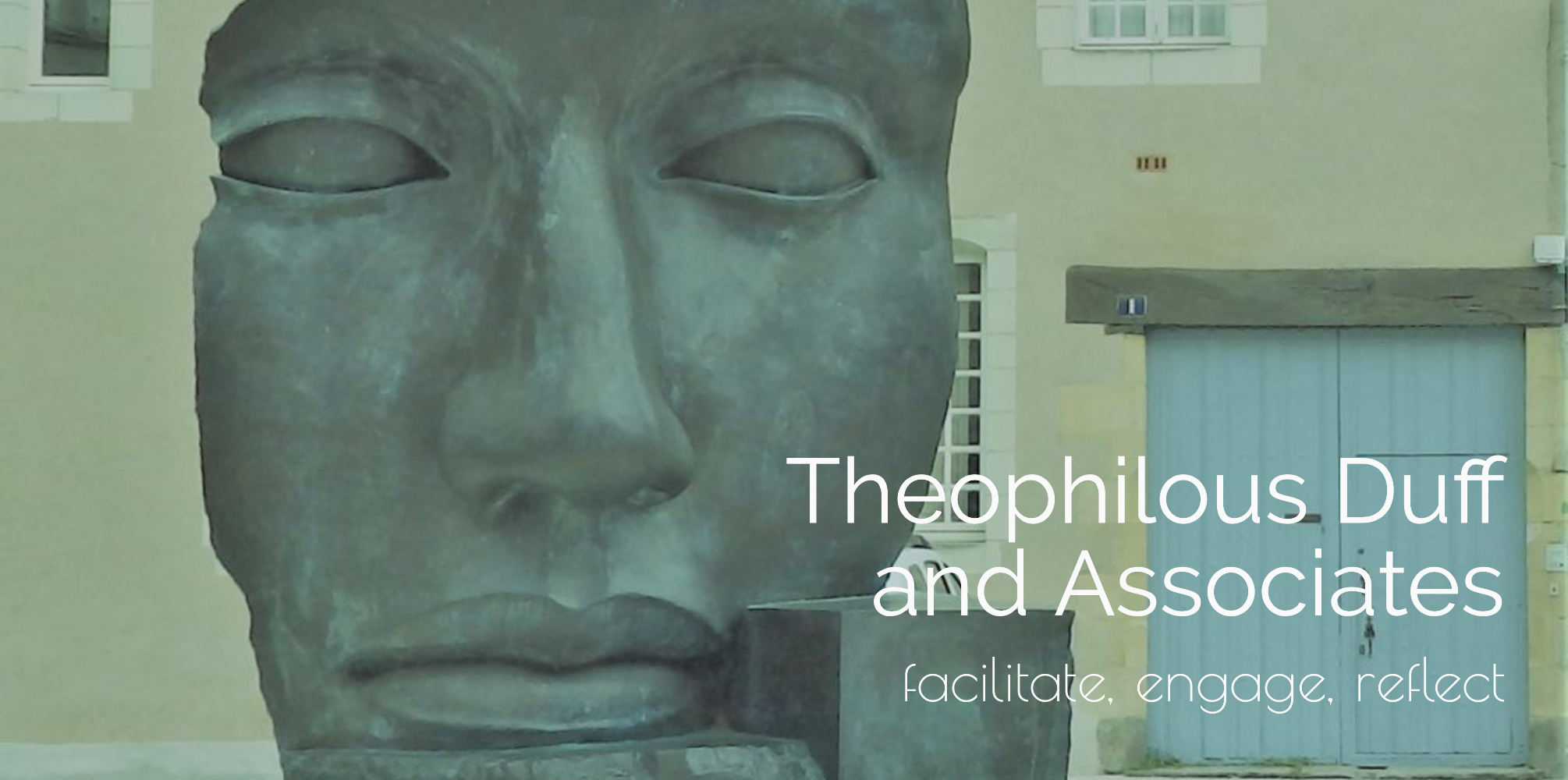Hong Kong and Japan – a travel blog – 43 years on
Our first stop was Hong Kong for a few days catching up with cousins living in the New Territories. We have been to HK a couple of times since the 1980s, with the kids en route to the UK. This is the first time seeing it through the eyes of someone who lives here. The city and the territories are much more built up than we remembered though there are still some corners of traditional Hong Kong here and there in street markets and narrow streets. Clearly, the locals know the value of shopping centres as a means of parking in Kowloon and HK Island and traversing the extensive passageways below ground lined with all manner of shops and restaurants including Marks and Spencers and multitudinous designer stores to get to another exit or your destination. We took the escalator from the Central Station up to the colonial era Police HQ on HK Island which now houses restaurants like Madame Fu and an interesting Museum too.
The Peak Tram brings you to the Peak and its viewing platforms with views of the city as it is now spread out below. Many of these towers are flats for housing the ever-growing population.
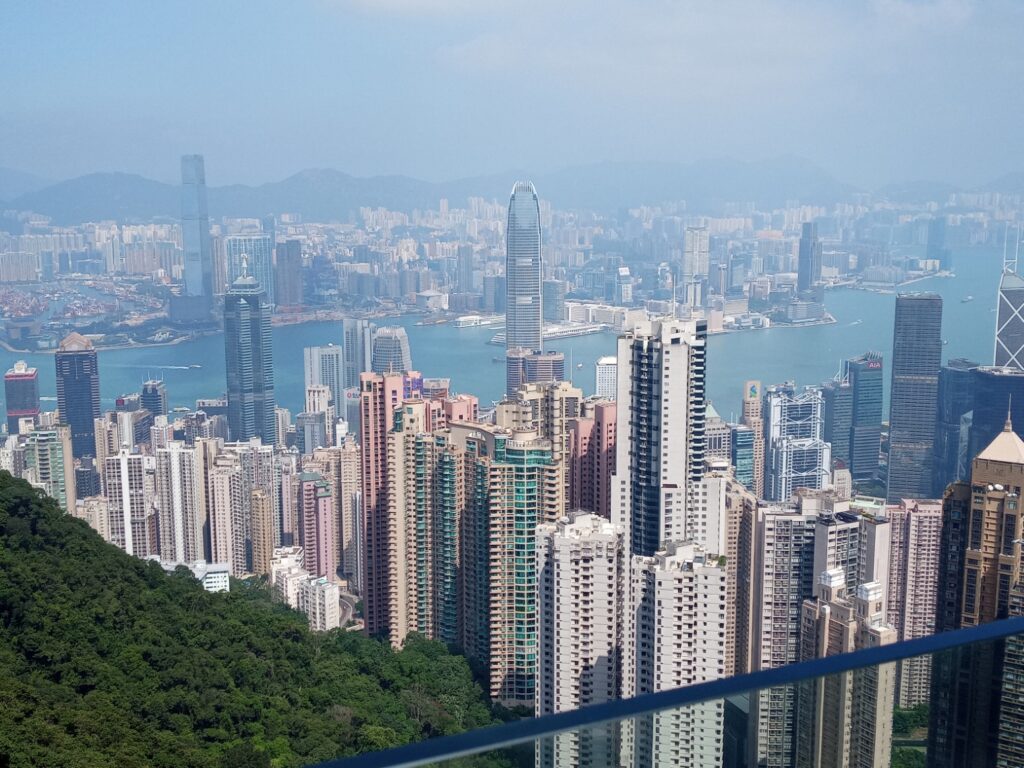
The metro transport system is excellent, clean and reliable. Purchase an Octopus Card on arrival – you can load cash onto this card and use it for trains, buses, cafes, parking, supermarkets etc – anywhere that displays the Octopus sign.
Another viewing point is the Aqualuna Red Junk River Cruises, especially the evening Symphony of Lights Cruise with the lights and laser show.
For a reminder of colonial times, spoil yourself with afternoon tea at the Peninsula Hotel – probably not for budget travellers but definitely an experience!
Next destination – Osaka, Japan
Revisiting somewhere after such a large period of time provides some interesting observations both on what has changed, evolution, if you like, and the many similarities. We visited Japan in November 2024, as grandparents, well-travelled and with significantly more available funds to call on. In 1981, we were commencing a 10-month long journey backpacking through Asia starting in Tokyo with very little planning and to eventually return to the UK for a while. This year, we had just over 2 weeks to spend in a small part of the country and had planned every stay, car hire and some excursions with our travel agent.
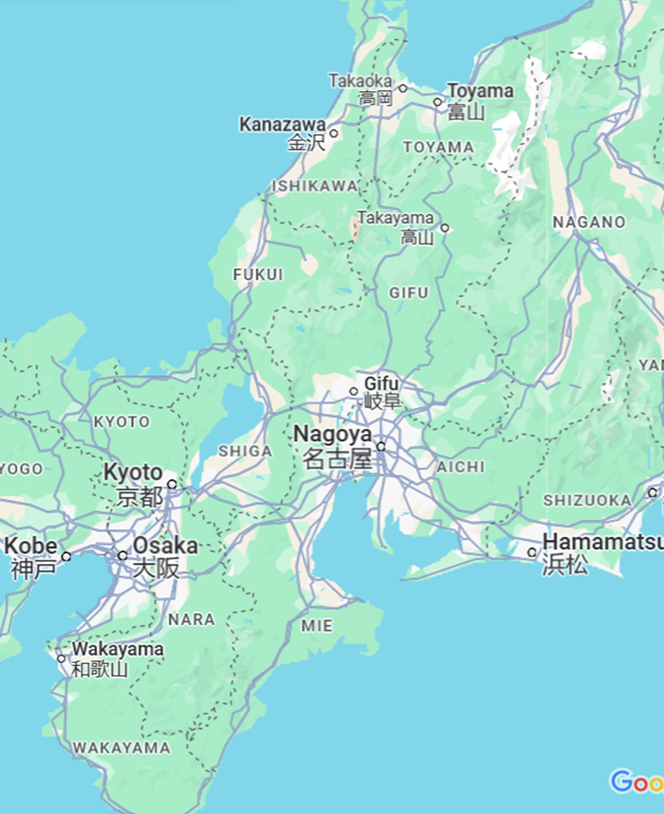
Immediately we arrived in Osaka we were struck by the westernisation of the city, English signage everywhere, franchised American burger and coffee outlets, westerners in abundance and the Japanese are taller and more solid physically. However, Japanese hospitality hasn’t really altered, they are very kind and considerate people who will always wish you a good day and thank you. A respectful nod of the head accompanied by a smile was nearly always positively returned and connection made as we travelled around the country, as were our ‘thank you’s’ with effusive ‘arigato’s’.
In 1981, we stayed with a friend in Tokyo who lived a walk away from Ginza which enabled us to spend over a week exploring the world’s most expensive city. In June 1981, the exchange rate was 254 Yen to 1 AU$ compared to the November 2024 exchange rate of 100 Yen to 1 AU$. Now a meal costs less than half what it does in Perth with the service and attention to detail far superior to anything we encounter at home. After many years of deflation and no wage growth, the Japanese yen has lost its 1980’s lustre and our visit was much less constrained by finances.
Journeying outside the urban centres was quite a challenge on our first visit with limited English either spoken or written and we spoke no Japanese. In 1981, we had a Rail Pass, and we relied on any maps we could source from visitor’s centres and our sense of direction or lack of it to various attractions and the local youth hostels. Google Maps definitely makes life much easier, especially when navigating motorways and the vast tunnelled mountain ranges by car. Although we did encounter a couple of glitches, we never really got lost and with every direction sign in two languages it was pretty easy to get around. The train system is similarly easier although the proliferation of different rail companies can be a bit confusing.
Driving in Japan is made so much easier by people’s risk-averse nature and desire to not offend other road-users. They do not tail gate, turn without signalling, go through red lights or speed in the city and so the experience is relatively straight-forward. On the motorways it isn’t as simple, however, as going with the flow seems to be more important on the tollways than going at the speed limit, often we were driving 100kph in an 80kph zone. Having said that we only witnessed one accident and rarely saw a damaged car being driven.
If anything, Japan seems more urbanised now with high rise covering the Osaka/Kyoto plains conurbation and rural life, or rice growing allowed to continue on any land that can be irrigated and cultivated. There is a respect for the countryside, vegetable plots are small and well-tended and little wasteland is seen anywhere.
We were struck by how much of a consumer society the country is now, and that Japanese would rank as some of the world’s best entrepreneurs. As we all know, Japanese products are now renowned for their quality and workmanship although foreign luxury brands are still widely appreciated within the country. As well as the designer stores in major cities and department stores, there is apparently a strong market for second hand designer gear too!
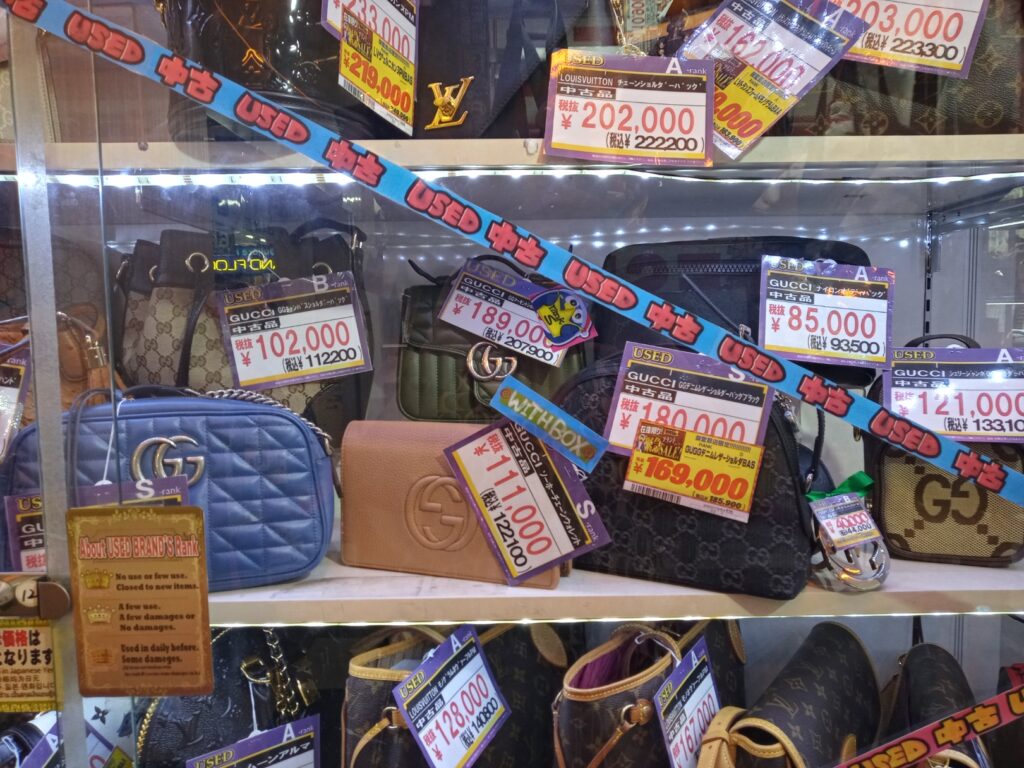
Don Quijote Stores are the place to go! A veritable cornucopia over several floors!
Japan is still a fascinating country to visit because of its ability to evolve with the times and yet retain many of its ancient ceremonies and strong historical ties. It was not nearly as challenging or expensive to travel around compared to our 1981 visit but still equally safe and hospitable. Go if you can and drive, train, walk, ride bikes, ski – it’s all possible.
There are lots of interesting places to visit away from the major cities and tourist attractions; in fact, we actively avoided places with lots of coaches parked outside and groups of tourists rushing along following a flag or a raised umbrella.
So, just a few highlights along the way…..
Using our pre-purchased train ticket, we took the train from Kansai International Airport into Osaka – about 40 minutes with several suburban stops along the way. We stayed at Cross Hotel in Namba (great breakfast!) and once we had exchanged our bits of paper for Kanzai 3 day train passes at the nearby Don Quijote Store, we explored the metro/rail networks, often traversing vast underground shopping malls to get from exit to platform to exit etc. Google maps was a great help as it tells you what platform to take and how far away you have walked from it too!
One day we took a local train back towards the airport to visit the Sumiyoshi Taisha Shinto Shrine
Set in a quieter suburb, with just a few patrons and a 5-minute walk from the station, we enjoyed a quiet wander around the grounds with centuries old camphor trees and various temple buildings – worth a visit to get away from the hustle and bustle.
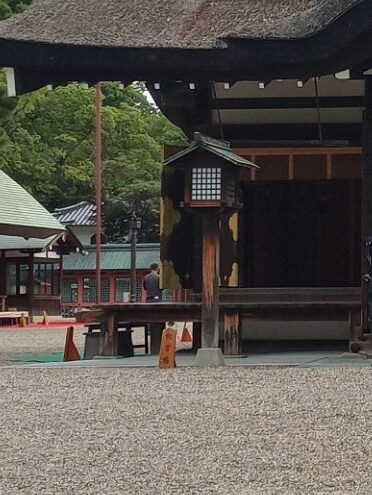
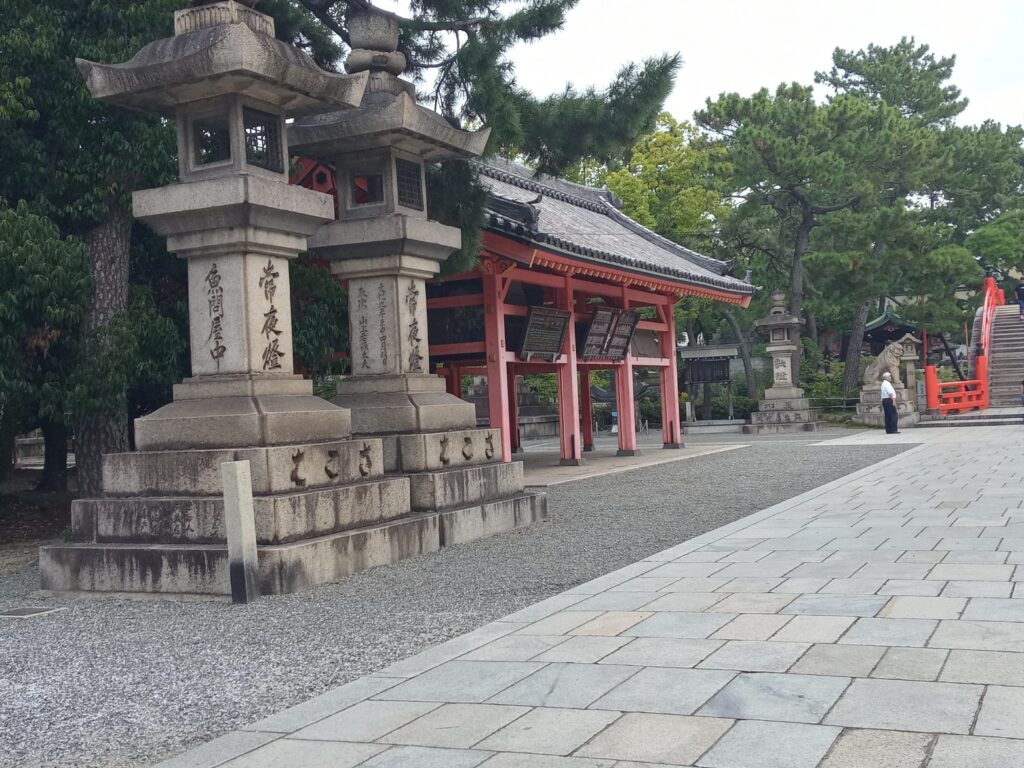
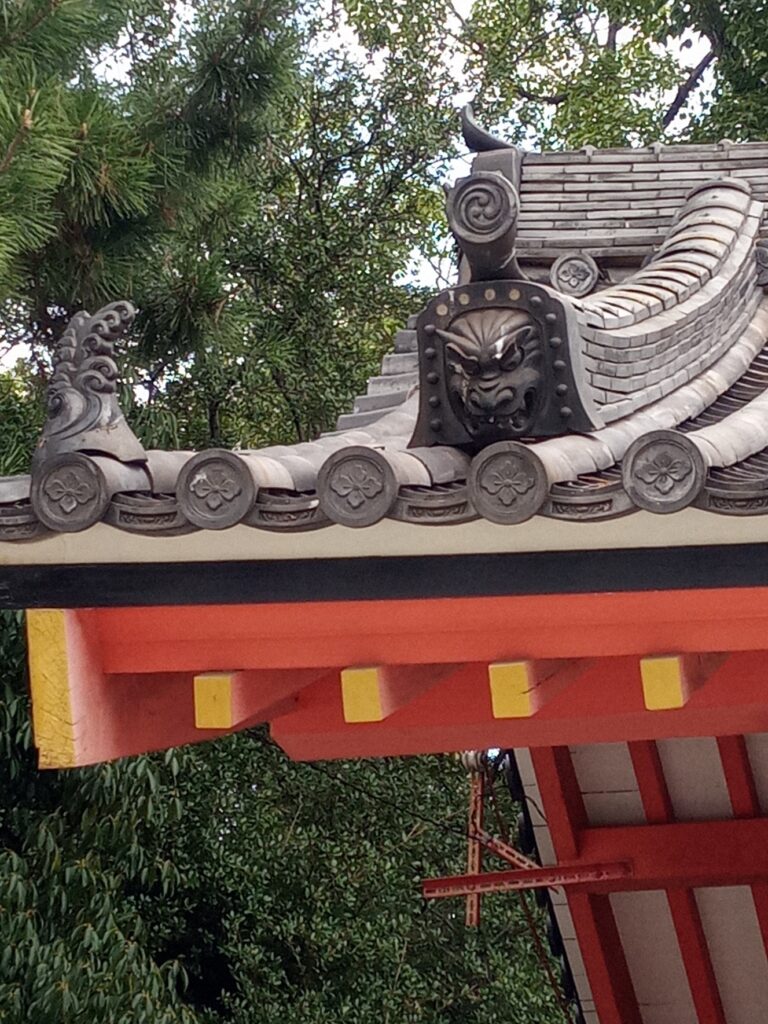
Sumiyoshi Taisha Shinto Shrine
Japanese food is widely appreciated in Australia now, whereas on our first visit we had rarely encountered it before and had to choose from the plastic food displays in the restaurant windows using hand gestures and pointing! There is now some westernisation of menus and a simplification of choices available in many restaurants but when we stayed in a traditional inn, a Ryokan and also in a Buddhist temple we were reminded of the great variety and wonderful tastes of Japanese cuisine. Breakfast can be a bit difficult for the western diet – seaweed, rice and fish are not something we usually start the day with – however, the preponderance of pickles, kimchi and eggs were fine and the occasional café chain sold a range of French bakery items and reasonable coffee. The only real negative was a lack of interesting gluten-free options nearly everywhere.
In one Noodle café, when we mentioned GF, they brought out a list of all the various dietary codes to check and their menu had notes in English under each dish with ingredients, wheat, etc. However, despite their eagerness to help, they still didn’t have GF dishes apart from plain rice and Sally opted for chicken curry as she was pretty hungry by then!
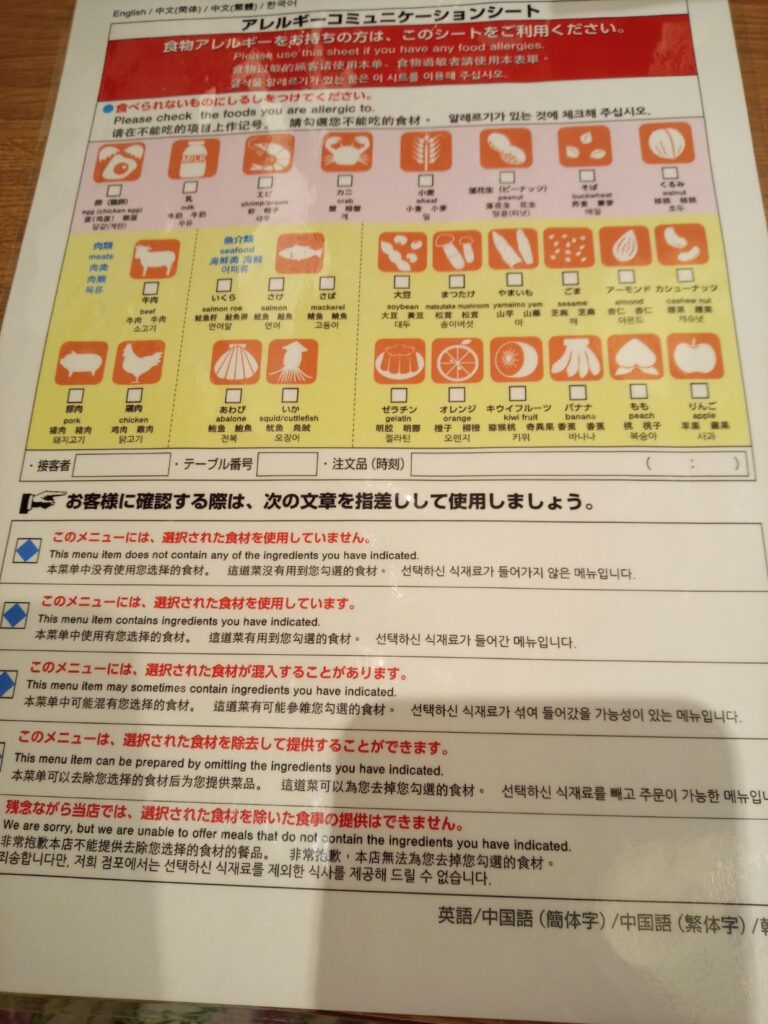
Dietary notes!
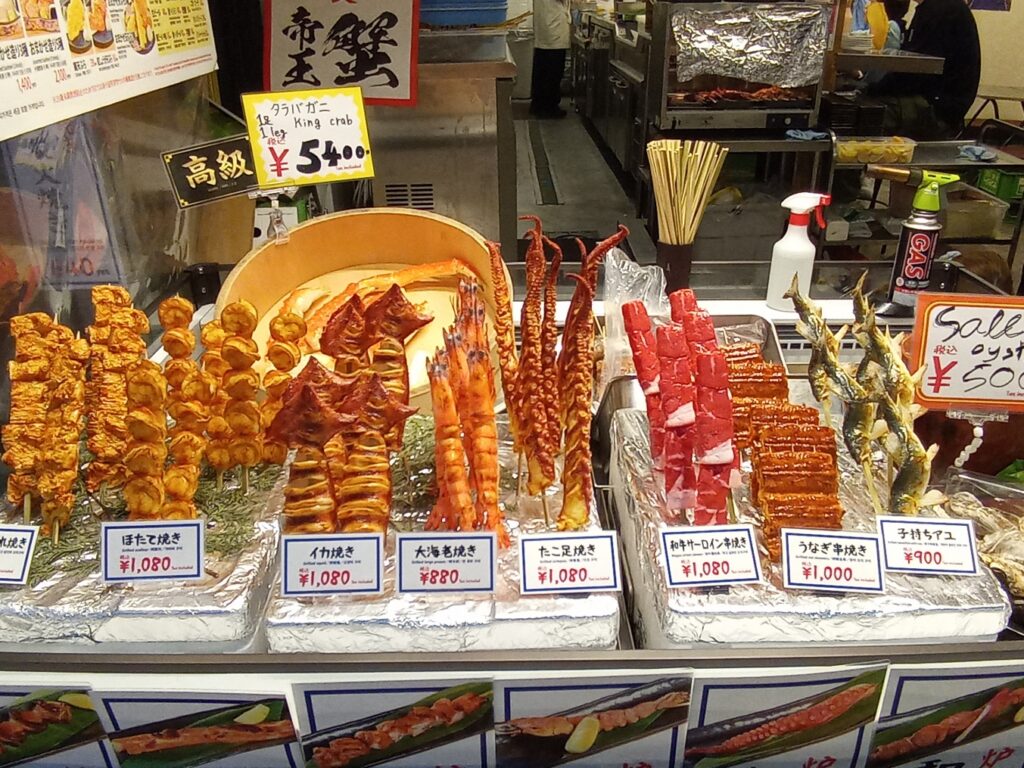
Market food stalls!
You can buy food almost anywhere from department stores, supermarkets, 7-Elevens and Lawsons, Family Stores or motorway services, as well as markets, cafes and restaurants, of course! For some reason, there are a lot of French Bakeries and Coffee Houses too! The ubiquitous and very yummy Kyoto Style Egg Sandwiches or ‘Dashimaki Tamago Sando’ make a great brekkie or lunch choice – soft fluffy bread and perfectly folded omelette filling. Not GF of course, but, luckily, I can transgress sometimes! I found small rice flour pancakes stuffed with blueberries at 7Eleven for breakfast and SoyJoy bars for a quick GF snack. Also check out https://fukuokaeats.com/eats/gluten-free-japan
The basements of department stores are well worth a visit to be delighted by the huge range of food available, all spectacularly well presented. The Food market at Umeda Station is worth a visit to pick up lunch before you walk to visit the Umeda Sky Building to check out the skyline!
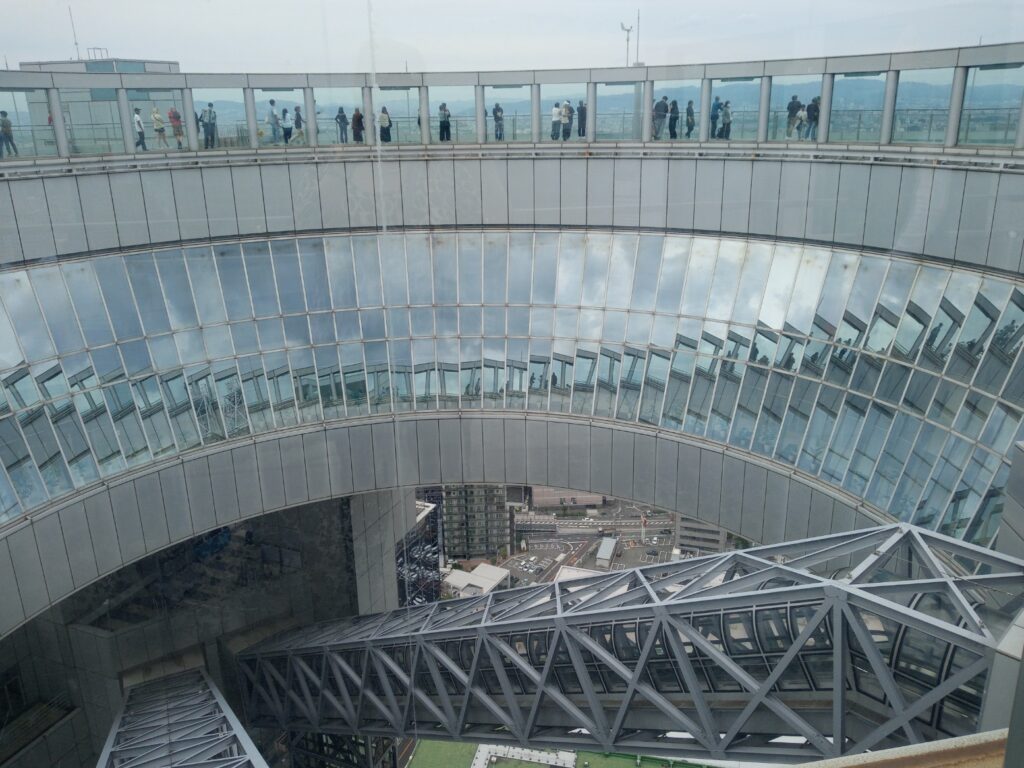
Umeda Sky Building
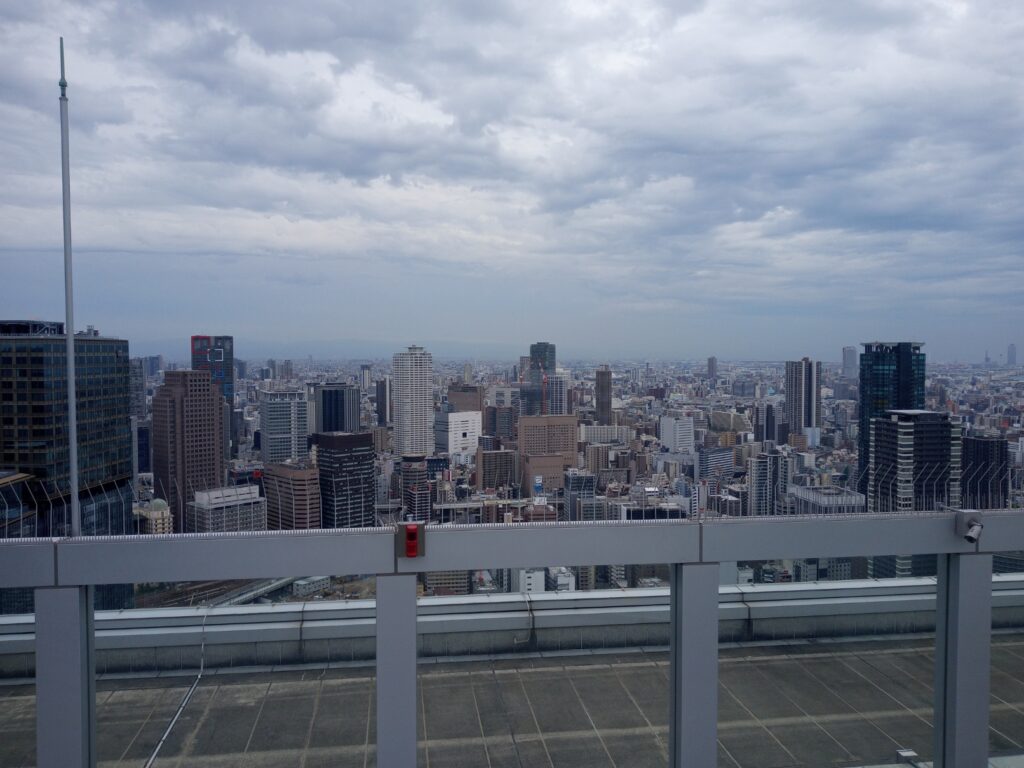
Osaka Skyline from the Sky Tower
Osaka Castle and its surrounding parklands and buildings provide some lovely trees and gardens to wander through, some well-tended and manicured and others natural woodland spaces to get away from it all for a while.
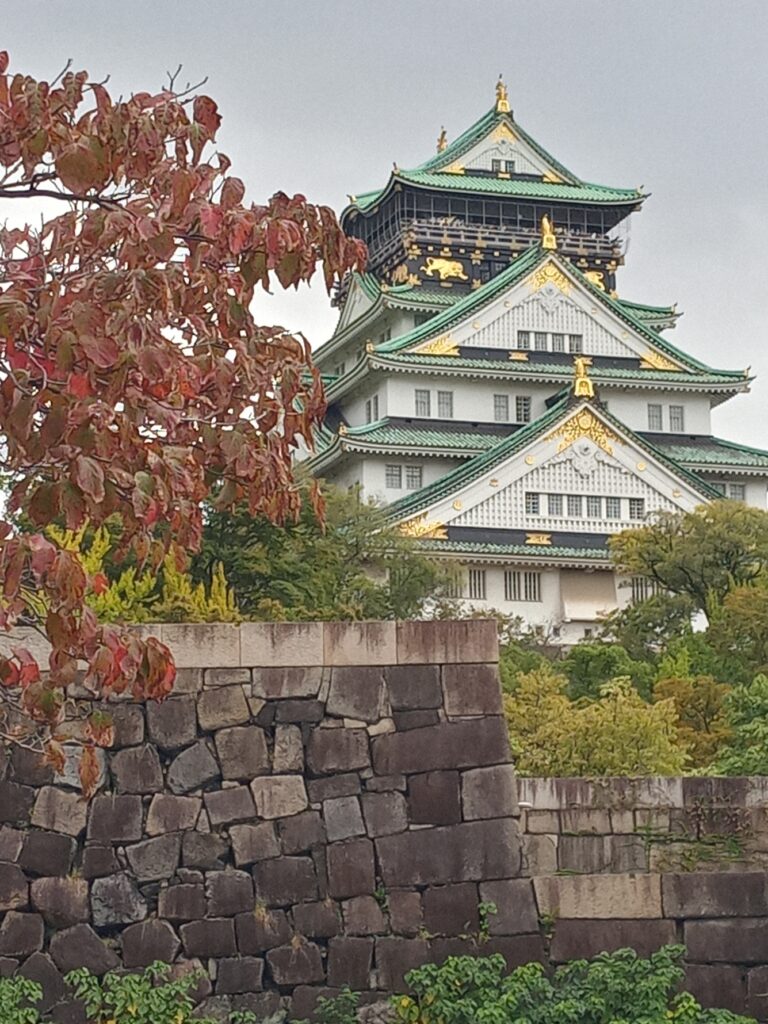
While the walls are immense, the castle has been rebuilt a number of times – as often happens in Japan due to fire and rotting timbers. There was a queue to get in and we decided to just enjoy the gardens with some of the foliage turning bright autumn red. The nearby Osaka Museum of History is interesting too and worth a visit.
Are you 65 years+?? If you can show a driving licence or passport with your date of birth and a photo, you can sometimes get a reduction in entry prices at Museums and places of interest. The Wakayama Museum of Modern Art gave us reduced parking fees as well as free entry to the exhibits! Always worth checking! The Café is cute there too.
Kyoto
We took the local train to Kyoto – with one medium sized suitcase and a small backpack, there were no issues on the train with luggage etc. Our hotel Forza was beside one of the exits a few minutes’ walk from the railway station – again a clear, well signposted underground pathway from the station. Most station platforms have lifts and/or escalators which are clearly signed and save tackling a few staircases with tired feet or luggage.
We had pre-booked a guided twilight small group tour of the Geisha Gion district with Context Travel who have a range of guides including Marcin, a university lecturer, who gave us a sympathetic yet comprehensive tour of the district. The Geiko and Meiko are now understandably very wary of tourists who want to take photos and treat them as objects for Instagram and they are more likely to travel from house to house by car now rather than walking. We didn’t take any photos.
Kyoto is known for its many temples, and we visited some of the less well frequented by tourist buses.
Kennen-ji is in the Geiko District and has spectacular wall and ceiling paintings and very calming Zen gardens.
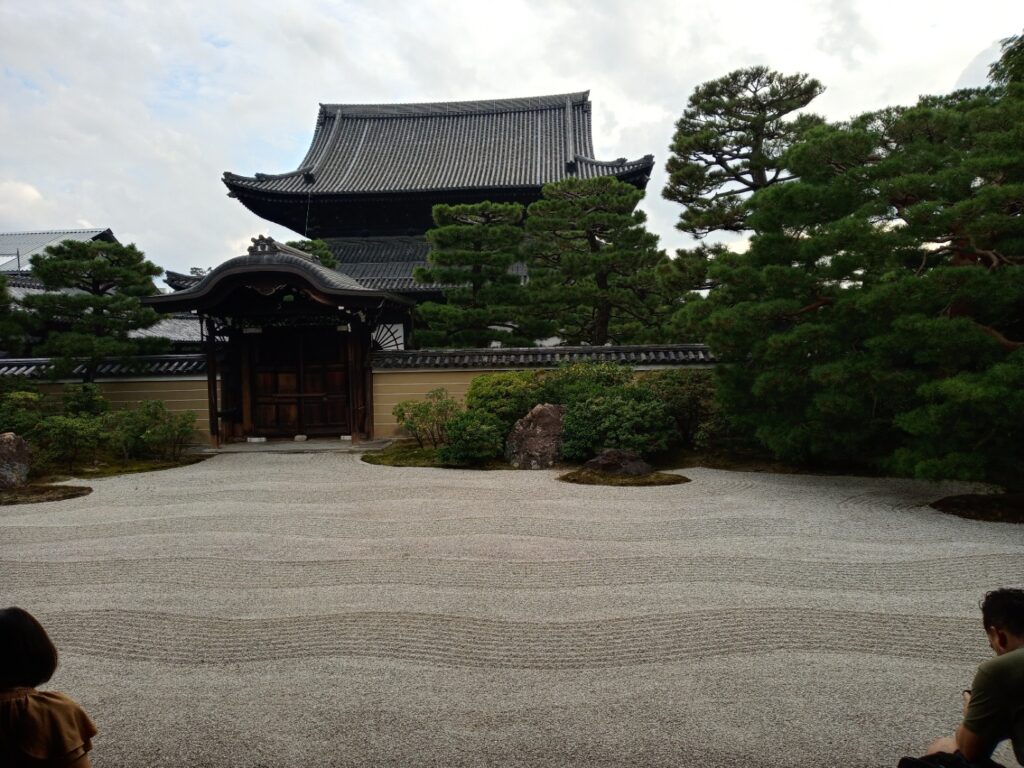
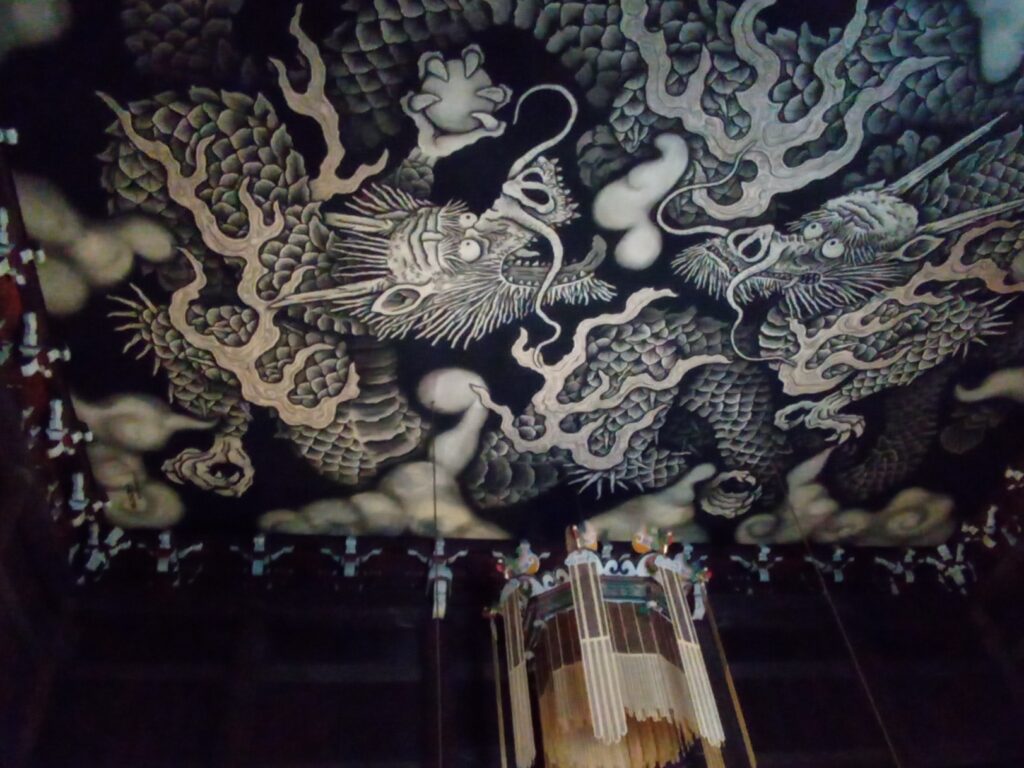
Staying with the train theme of the first few days in Japan, a visit to the Kyoto Railway Museum – great for train buffs and kids too.
We picked up our car in central Kyoto – a small Nissan with an ETC toll road card fitted and with the help of google maps found ourselves on the road! Check for costs etc.
En route to Kanazawa, we visited the excellent Museum at Hikone Castle which shares a large collection of Samurai heritage.
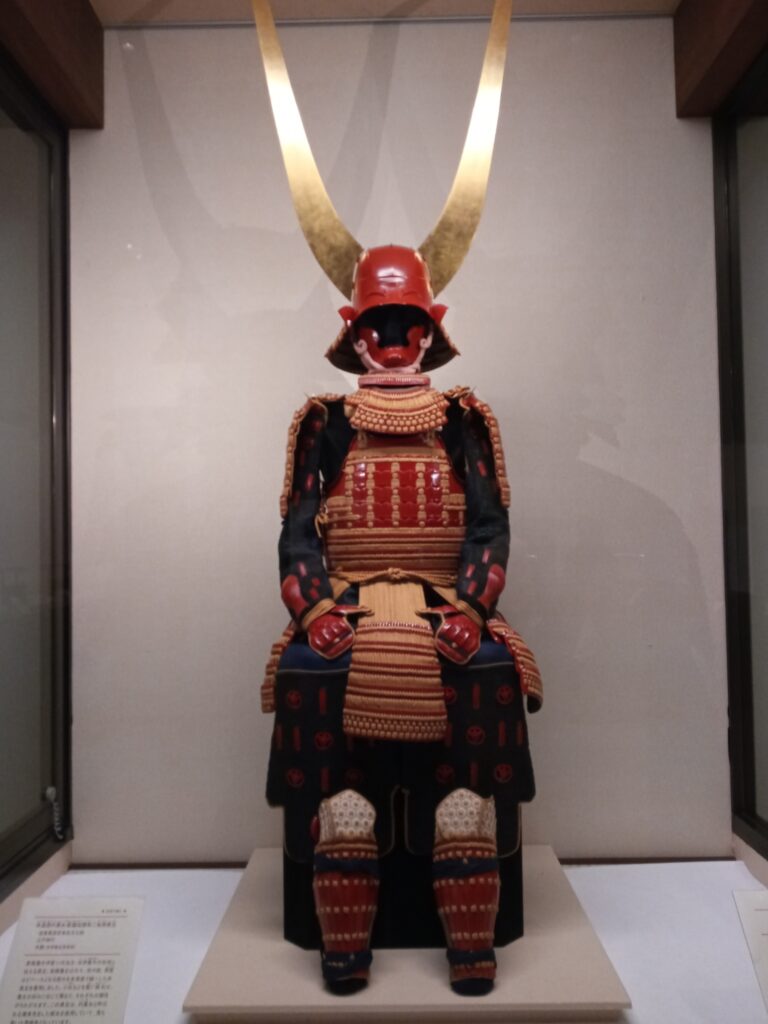
At Kanazawa, there was another Samurai museum in the streets behind our hotel. A walkable city, we enjoyed exploring the Kenrokuen Gardens above the Castle
Driving from Kanazawa via Toyama to Nagano, we saw the coast, the inland and the mountains with many tunnels and lots of forested hillsides with hints of autumnal leaves turning red here and there.
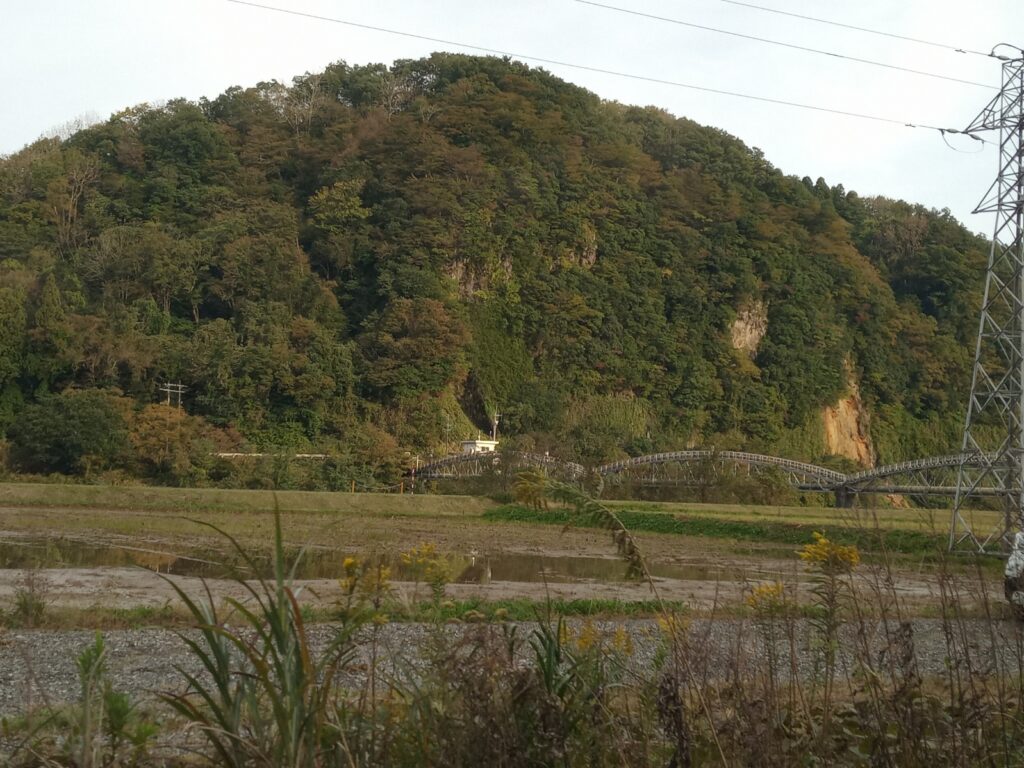
Situated beside the Zenkoji Temple in Nagano, the Matsuya Ryokan was our first experience of Japanese style accommodation this trip, with traditional Japanese style rooms, tatami matting and bedding on the floor (they do have rooms with beds too). The hospitality experience was excellent with helpful staff and excellent food for dinner and breakfast (set menus). One day we drove out to see the Snow Monkeys but they were not around – check with the website re seasons etc. We saw some lovely countryside and trees lining the road with the biggest apples!
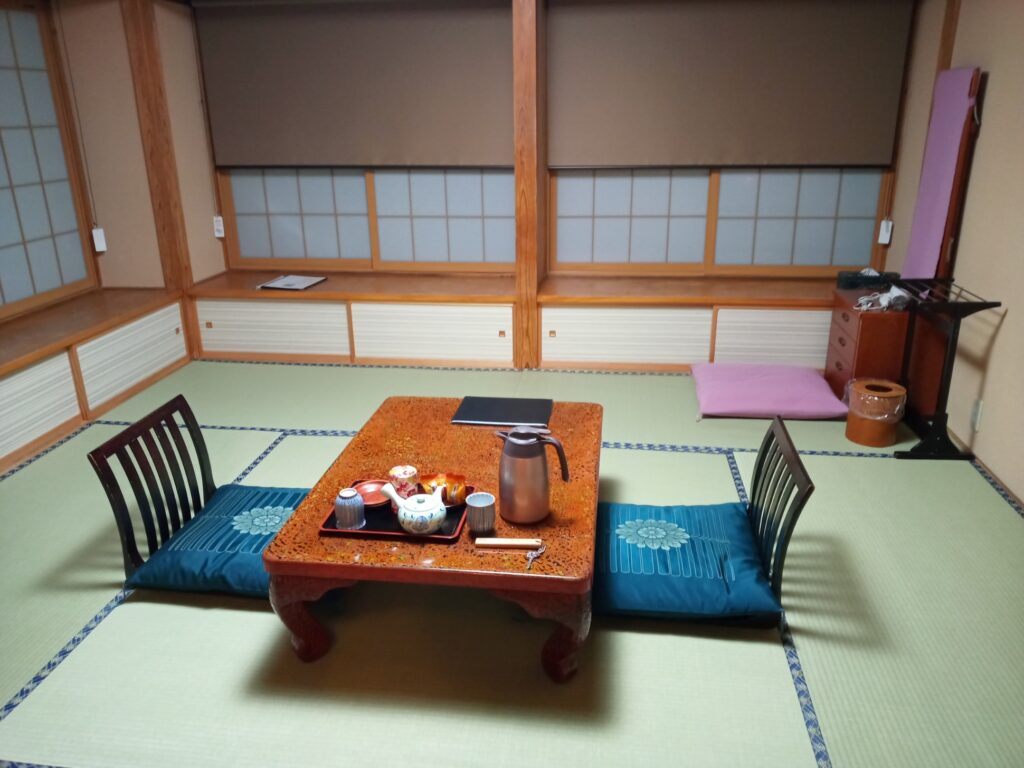
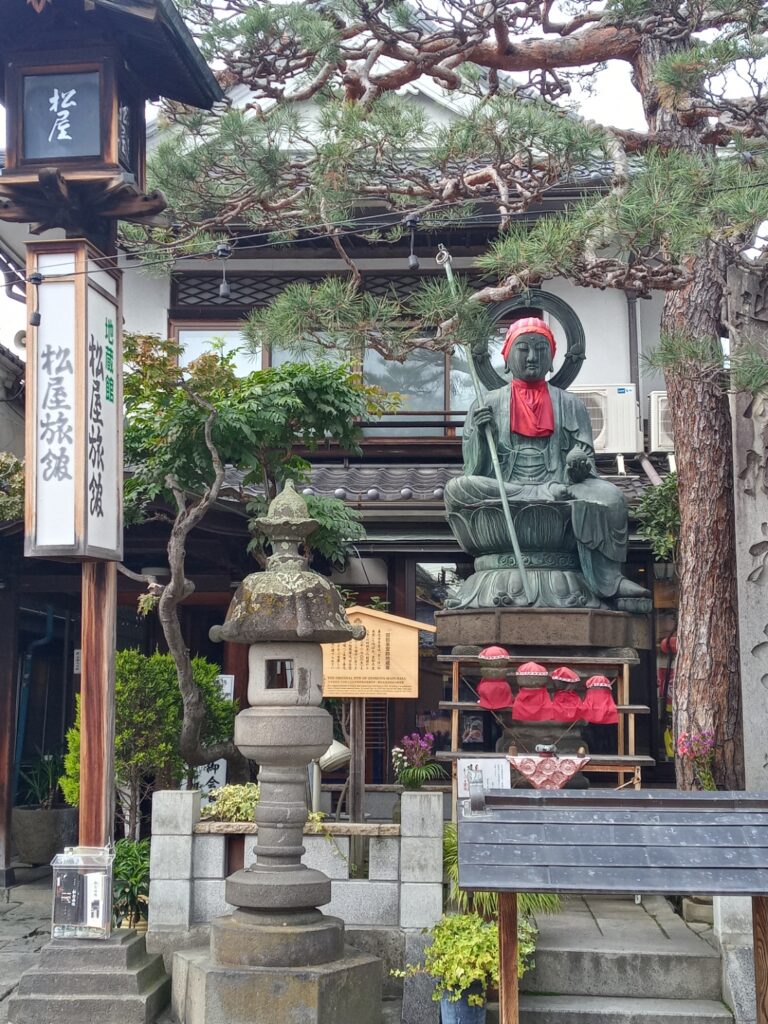
We drove to Gifu through a very rainy day – the tail end of a typhoon or similar. The next day was National Day in Japan, and many families were out and about visiting the Castle via the Mount Kinka Ropeway and quite a lot more steps!
Later on, we found a quiet time to visit Shobo-ji Temple with its immense lacquer statue of Buddha.
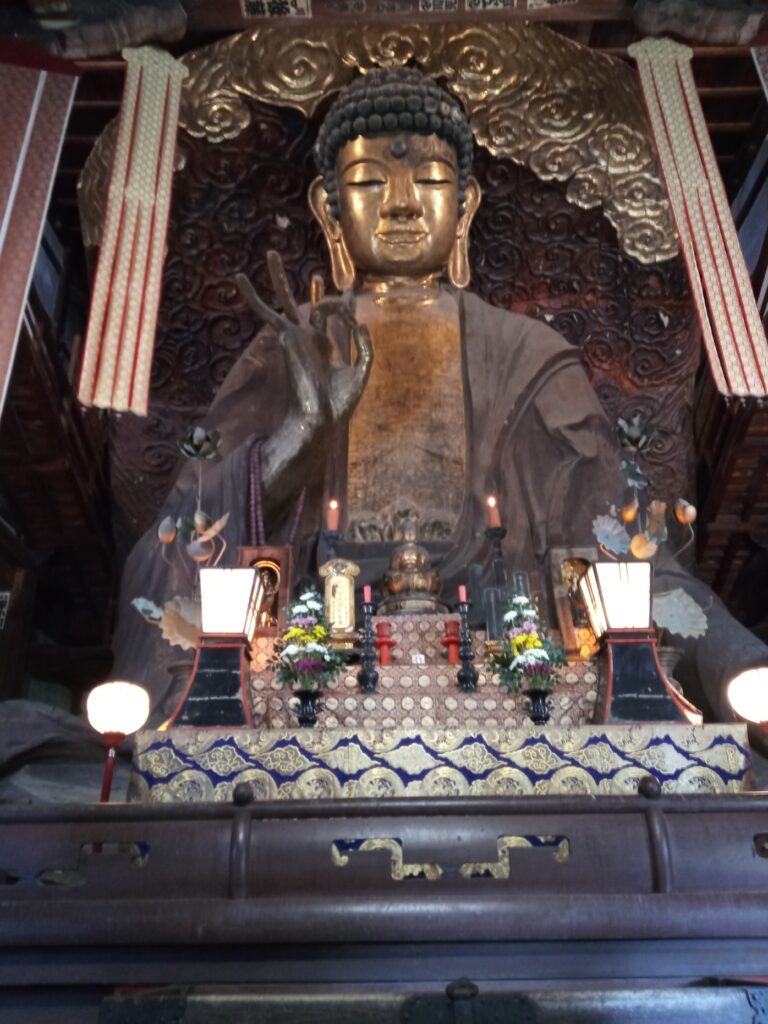
Check the season dates for Cormorant Fishing at night – we missed this.
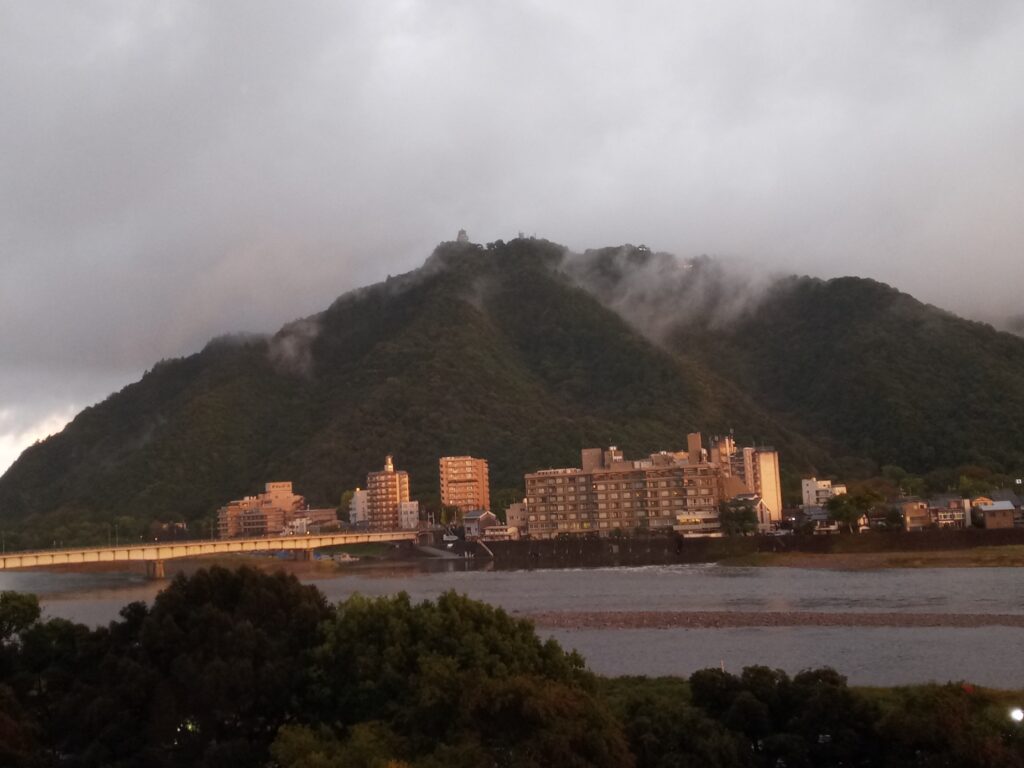
Gifu
From Gifu we drove to Mie on the coast near Shingu. A few pretty windy roads brought us to discover the Nachi Falls and the Taisha Shrine. Many steps down and back up again with a handy handrail!
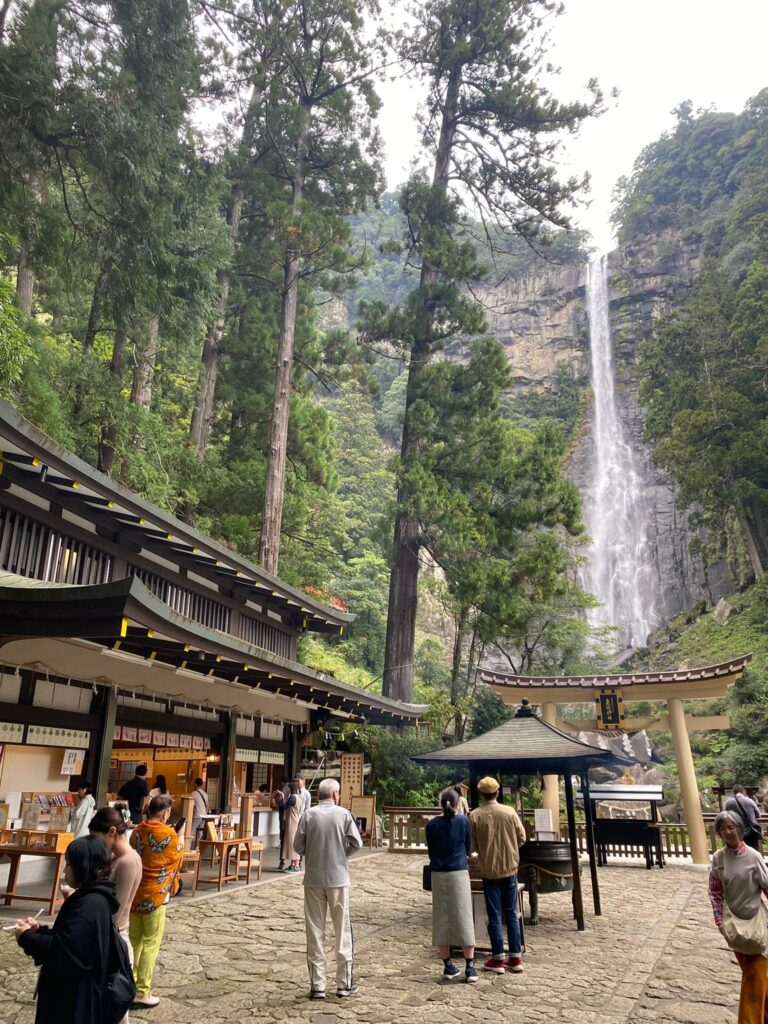
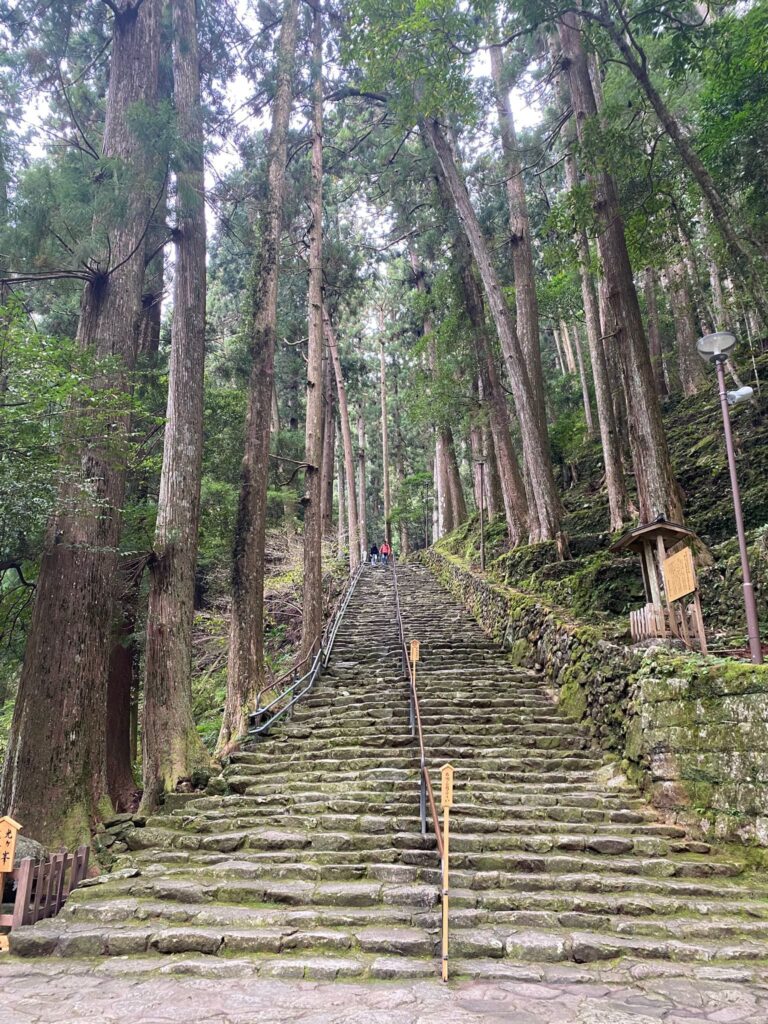
Steps down and up – Nachi Falls …with handrail!
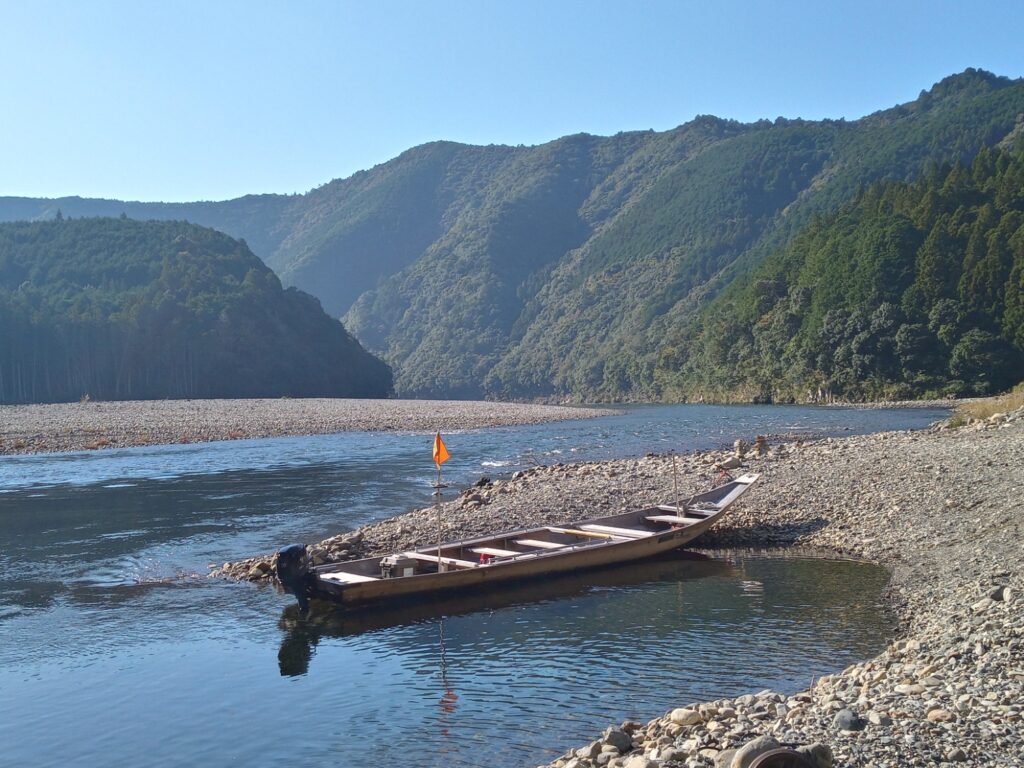
The Kumano Hayatama Taisha Shrine was another quiet and relatively bus free spot to visit. A small town along the river with cafes and rice paddies to wander beside.
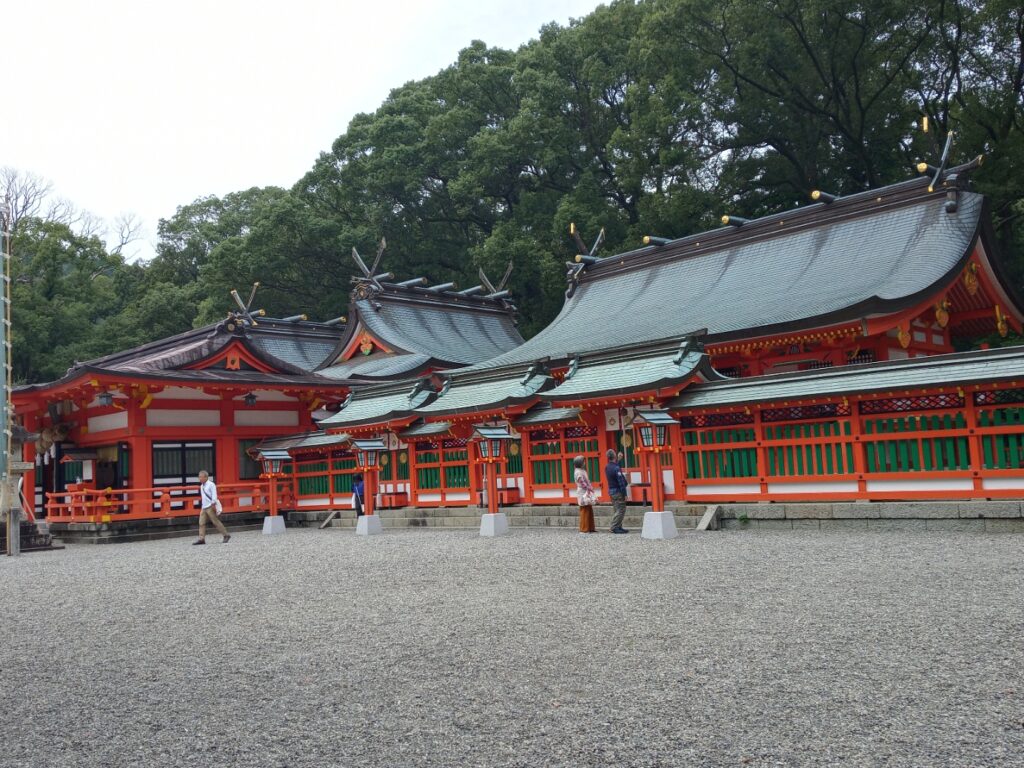
This area is part of the Heritage Listed National Park with many pilgrim walk trails and small villages to explore.
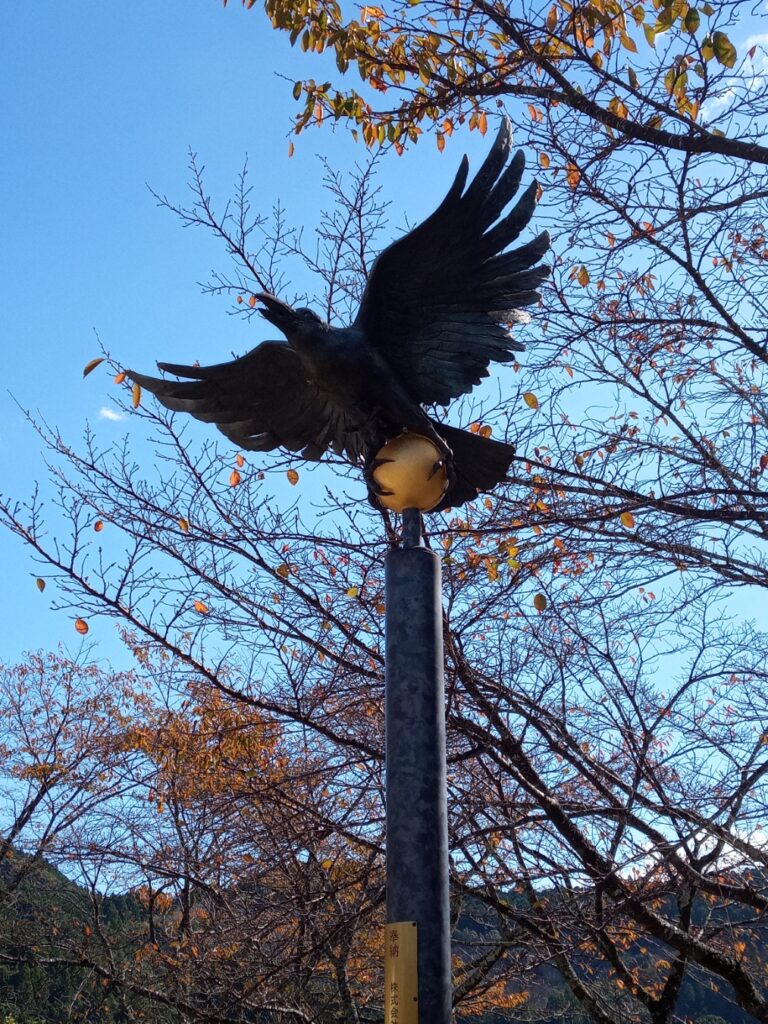
The Yatagarasu: The Three-legged Crow That Guided Emperor Jimmu on his Journey
A highlight of our trip, our last couple of nights before returning to Osaka was in Koyasan, staying at Fudo-In Buddhist temple .
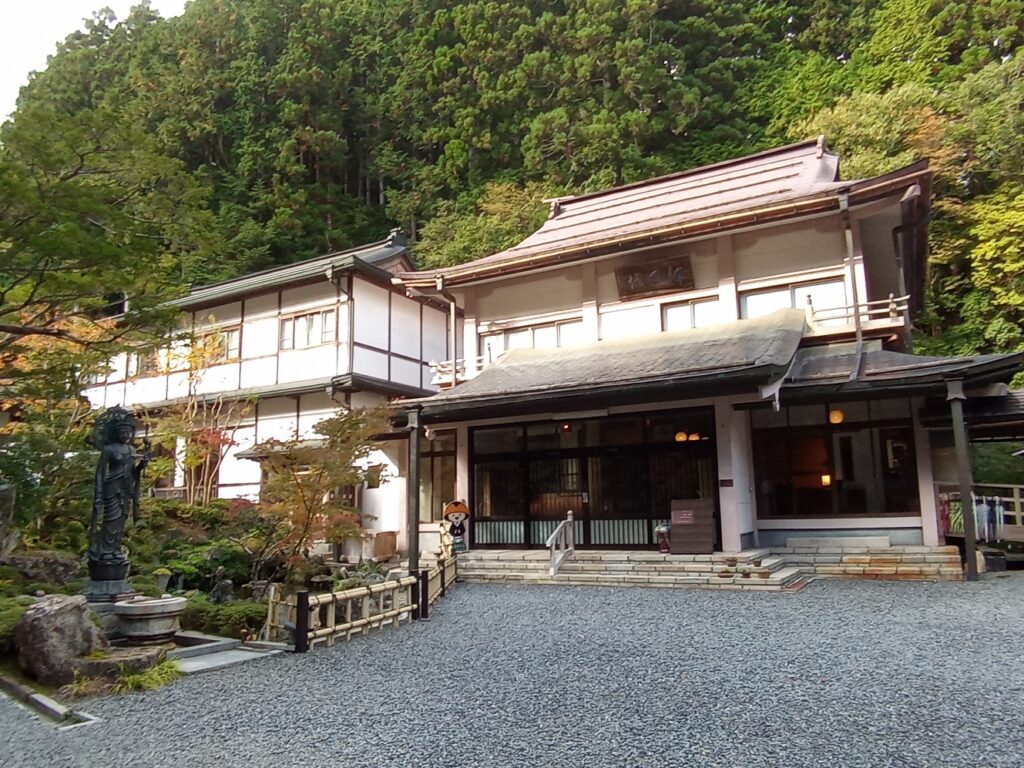
Fudo-In Buddhist temple Accommodation
It was a very windy drive through the mountains to Koya with more than a few hairpin bends though, thankfully, little traffic coming the other way! We were warmly welcomed by the Monks with room numbered slippers provided so you could easily recognise yours amongst a pile of others. We had a traditional guest room suite, albeit with a private modern toilet with a lid that sensed your presence and opened as you entered!
Once again, the vegetarian food served at dinner and breakfast was amazing and we also got up early to share the 7pm daily Meditation Service in the temple.
It was cold in November here at the top of the mountain. Quite a contrast to the previous couple of weeks when all that was needed was one top layer as opposed to the 3 layers against the cold and wind, we were glad of at Koyasan.
We wandered through this town of temples and the ancient Okunoin cemetery which stretches for a few kilometres along the main street through town. You can get guided tours or just wander through by yourself.
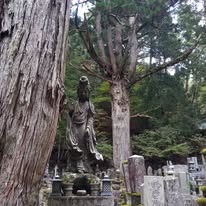
Returning to Osaka – time to go home
In contrast to Kayosan, our room in Rinku Town, near KIK Airport (Osaka) was on the 43rd floor of the hotel building. Fabulous views and good breakfasts on the 53rd floor and a free bus shuttle to the airport on arrangement with reception.
The day before leaving, we delivered the car back to Kyoto via Nara with only about AU$200 worth of tolls to pay for 8 days and 1800kms of travel around the region. So, yes, we recommend hiring a car as it gives a lot more flexibility about where you go, when and what you might see along the way, and it is so much easier to travel without worrying about carting luggage on buses and trains.
Just a couple of final comments!
There is a lot to see and do in Japan – and, yes, we didn’t see tea ceremonies, origami workshops, theme parks, sumo wrestling and onsens, walk a pilgrimage trail or ski – but we had a wonderful holiday exploring a small part of the country and doing it our way! Don’t try to fit too much into your time in Japan – have some time to just wander, explore, try new things, enjoy, meet people and relax too.
Toilets! Very important for people with limited capacity! These are plentiful, easily found, accessible, very clean and heated toilet seats are a real treat with privacy music and full-service bidet options with instructions if you wish to partake! NB the Rushing Water sounds are privacy ‘music’ not broken pipes about to gush all over you!
